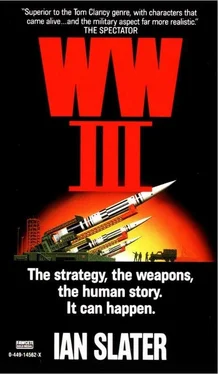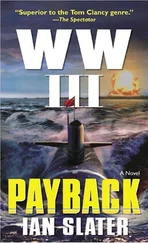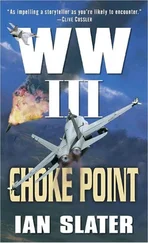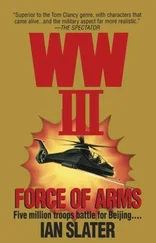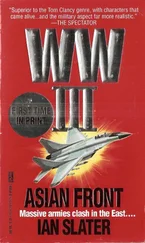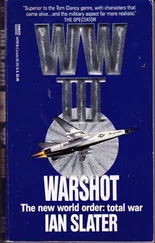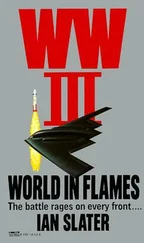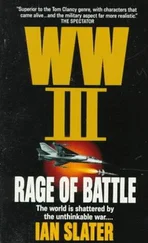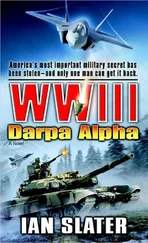Ian Slater - WW III
Здесь есть возможность читать онлайн «Ian Slater - WW III» весь текст электронной книги совершенно бесплатно (целиком полную версию без сокращений). В некоторых случаях можно слушать аудио, скачать через торрент в формате fb2 и присутствует краткое содержание. Год выпуска: 1990, ISBN: 1990, Издательство: Fawcett, Жанр: Триллер, на английском языке. Описание произведения, (предисловие) а так же отзывы посетителей доступны на портале библиотеки ЛибКат.
- Название:WW III
- Автор:
- Издательство:Fawcett
- Жанр:
- Год:1990
- ISBN:978-0449145623
- Рейтинг книги:3 / 5. Голосов: 1
-
Избранное:Добавить в избранное
- Отзывы:
-
Ваша оценка:
- 60
- 1
- 2
- 3
- 4
- 5
WW III: краткое содержание, описание и аннотация
Предлагаем к чтению аннотацию, описание, краткое содержание или предисловие (зависит от того, что написал сам автор книги «WW III»). Если вы не нашли необходимую информацию о книге — напишите в комментариях, мы постараемся отыскать её.
In Europe — Twenty Soviet Warsaw Pact infantry divisions and four thousand tanks begin to move. They are preceded by hundreds of strike aircraft. All are pointed toward the Fulda Gap. And World War III begins…
WW III — читать онлайн бесплатно полную книгу (весь текст) целиком
Ниже представлен текст книги, разбитый по страницам. Система сохранения места последней прочитанной страницы, позволяет с удобством читать онлайн бесплатно книгу «WW III», без необходимости каждый раз заново искать на чём Вы остановились. Поставьте закладку, и сможете в любой момент перейти на страницу, на которой закончили чтение.
Интервал:
Закладка:
Proceeding slowly through increasing fog, the two ROK destroyers were a quarter mile from the tanker when she dropped the hinged panels on both sides of her flying bridge, launching four Exocets at what was effectively point-blank range.
The first destroyer, hit both on the bridge and in its gun-control radar antennae, managed to get off one of its eleven-hundred-pound Harpoons, the missile’s aim thrown off, however, by the cluttering images of its own bridge’s flying debris. It missed the tanker by a wide margin. The second ROK destroyer was already a mass of flame, both Exocets having exploded at the waterline, the fuel tanks ruptured, men drowning in oil. Undeterred, the tanker, jamming the picket destroyer’s radio calls for help, maintained a steady heading toward Pohang Harbor, using the southern curve of Yongil Bay, not hit by the bombers earlier in the day, as a reference point, its quaint, old-fashioned jumble of hotels rising higgledy-piggledy above neat rows of advertisers’ red, white, and green beach umbrellas.
On the golden crescent of Yongil Bay, confused and terrified tourists, including members of the local “Pohang Pelicans” who earlier had been readying for their monthly predawn dip when the Backfires had appeared, were now stunned as the city proper across the big bay and now the destroyers continued to be consumed by the fire. As the tanker appeared, emerging from the early morning haze, it appeared to be disintegrating, as if, one of the waiters from the Sun Day hotel commented, “pieces of it were peeling off.”
No information could be gained from Pohang Central, telephone communications and roads having been cut by the bombers’ raid. Only two inhabitants in all of Yongil Bay could remember anything like it — the great fires lit by the retreating U.S.-ROK forces over fifty years ago when, in pell-mell retreat from the pursuing NKA, the Americans and South Koreans had frantically gone round torching massive supply dumps, denying them to the Communists. This time, however, Pohang had been attacked not by NKA artillery but by its air force, the Backfires flown by Norm Korean veterans who had served in the Syrian air force in the Arab-Israeli wars and who, against all prediction, had come in so low on the final run before the “hop” over Pohang and Taegu that they had been no more than forty feet above the waves. It was for this reason that the USS Blaine, now approaching the area at 0817, had earlier picked up only one of the bombers as a faint and inconclusive blip on its radar.
At 0823 a fisherman, trying his luck six miles off Cape Changgi in wind-scattered mist, saw that what those on Yongil Beach had thought were pieces of paint, or scales, flaking from the giant tanker were in fact swarms of APCs, amphibious personnel carriers, and other assault boats, carrying two thousand NKA marines and flanked by two Nanuchka guided-missile patrol boats. All had slid effortlessly from the tanker’s roll-on, roll-off stern cavity, each patrol boat armed with a twin fifty-seven-millimeter AA gun, a single seventy-six-millimeter AA gun, one thirty-millimeter general-purpose Gatling, and two triple-loaded N-4 (NATO-designation “Gecko”) air-to-surface missiles with a range of six nautical miles. It was not realized at the time, but these were the first Nanuchka Class IIIs the West had seen.
As soon as she understood what was happening, her radar and radio signals to the U.S. Naval Advisory Group in Pusan still jammed, the lone ROK destroyer off Cape Changgi joined battle, engaging the two patrol boats at a range of eight nautical miles. She destroyed one of the Nanuchkas with a Harpoon missile, but the other patrol boat closed in a fast “weaving” pattern to six nautical miles, putting the destroyer within range of the Nanuchka’s SA-N4s. Firing all six missiles, the patrol boat hit the Korean destroyer with three of them. It was not the explosions themselves that did in the destroyer so much as the resulting fires amid the massive structural damage, fires that could not be fought effectively, as most of the water lines had been severed or punctured by white-hot splinters, the Russian-built missiles slamming into the ship at six hundred miles an hour. The fires heating the aluminum superstructure caused massive blistering on and between decks, filling the air with highly toxic fumes from incinerated plastic moldings, the fumes alone responsible for half of the destroyer’s eighty-three casualties, thirteen of whom had been killed outright by the missiles’ impact.
Disgorged from their mother ship like sharks from the belly of some great whale, the armada of landing craft, 140 in all, wasted no time heading toward Pohang Beach, churning the gray sea white while a flight of twenty bulbous-eyed Kamov-25s rose from the bowels of the supertanker, their distinctive double-decker contrarotating rotors catching the weak morning light as they passed over the wakes of the assault force. Armed with air-to-surface rockets under each stubby wing and 20-millimeter nose cannon, ten of the twenty Kamovs, each carrying twelve SPETSNAZ or special force troops, ferried 120 a mile beyond the beach. The other ten Kamovs took another 120 SPETS twenty-five miles inland, south to the Kyongju junction on the vital east coast rail link between Pusan and Seoul.
To thwart any possible counterattack from what was left of the American base at Camp Libby, or from the USMC Advisory Group garrison two miles south of Yongil Beach, NKA commanders knew the beach must be reached in under twenty minutes. For this to happen, the first wave of commando-trained assault troops plus combat engineers had to be in action the moment their amphibious tracked vehicles hit shore. They would be followed, at three-minute intervals, by a second and third wave, each containing more riflemen and antitank weapons, followed by the fourth and final wave of a battalion of forty PC-76 Plavayushchiy amphibious tanks, each up-gunned to a 105-millimeter cannon instead of its usual 76.2-millimeter gun, and sprouting a standard coaxial 7.62-millimeter machine gun atop its cupola.
But going in with the tide, as planned, the amphibious tanks, capable of ten kilometers per hour in calm water, now reached as much as thirteen kilometers per hour. The increased push of the surf helped conserve precious fuel that would otherwise have been expended in powering the tanks’ hydro-steer jets, but the saving in fuel was offset by serious steering problems as spray from the wakes of the amphibious personnel carriers ahead, now too close in front, “salted up” the tanks’ extended periscopes. This caused several of the PC-76 tank drivers to steer blind. The result in the heavy surf was over two dozen collisions, five of them fatal, as the twenty-five-foot-long, fourteen-ton tanks tore off each other’s trim boards between glacis and nose plates, each of the doomed tanks’ 240-horsepower water-cooled diesels driving them under before power could be shut off.
Despite the loss, the NKA commander knew that the advance force of 120 SPETS ferried in by the first ten helicopters held the key to success at Pohang Beach. And already he could see them through the binoculars establishing a small but highly concentrated perimeter of fire fed by hundred-round-per-minute AK-74s, PKMs (7.62-millimeter light machine guns), heavy mortars, and if needed, twenty-five-pound “Sagger” antitank missiles.
In all, over two thousand NKA regulars, a small but superbly trained force, were involved in the Pohang strike on a one-kilometer front. The NKA’s big gamble was that if the second 120 SPETS ferried twenty-five miles inland could sever the vital arteries of the Seoul-Pusan expressway and Seoul-Pusan rail link, then Pusan, the east coast’s major naval port, would be isolated, infiltration units already having cut the alternate route between Pusan and Taegu farther inland. With the beachhead at Pohang consolidated by additional troops securing it in depth, air strikes could then be launched from Pohang field against the U.S.-ROK naval installations at Pusan. Not only would the headquarters of the ROK navy be in the hands of the NKA, but the vital sea link to Japan and its formidable U.S. garrison would be severed.
Читать дальшеИнтервал:
Закладка:
Похожие книги на «WW III»
Представляем Вашему вниманию похожие книги на «WW III» списком для выбора. Мы отобрали схожую по названию и смыслу литературу в надежде предоставить читателям больше вариантов отыскать новые, интересные, ещё непрочитанные произведения.
Обсуждение, отзывы о книге «WW III» и просто собственные мнения читателей. Оставьте ваши комментарии, напишите, что Вы думаете о произведении, его смысле или главных героях. Укажите что конкретно понравилось, а что нет, и почему Вы так считаете.
